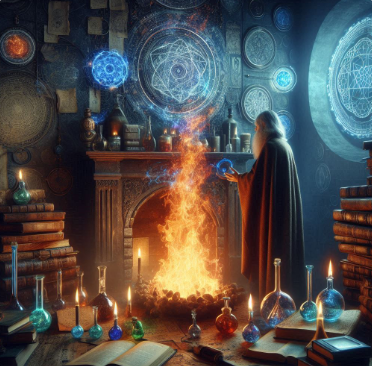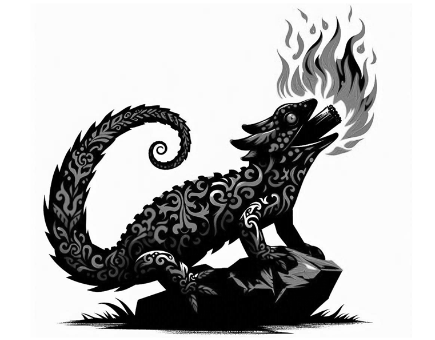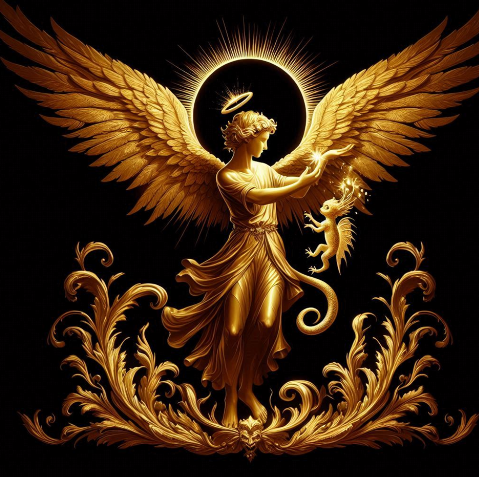In the Flames of Myth : The Salamander, Mysteries,Powers, and Symbolism of a Legendary Animal
- Julia Heisler
- Nov 7, 2024
- 6 min read
Author : Corinne RichardWebsite: https://www.frenchmysticgateway.com

The salamander, a creature shrouded in mystery, is associated with magical powers and symbolizes luck, prosperity, and protection against malevolent spirits. In many cultures, it embodies immortality, rebirth, passion, and an incredible resistance to flames.
Spiritual Symbolism of the Salamander
In Native American folklore, the salamander is viewed as a powerful spirit animal, representing healing, purification, and transformation. Its regenerative abilities are fascinating: it can reform parts of its body, including limbs, tails, eye tissues, and even brain matter. Unlike other animals like the lizard, which primarily regenerates its tail, the salamander can also repair complex organs such as the heart and spinal cord. Even the zebrafish, known for its cellular regeneration, only partially rivals the salamander in this regard.
The Salamander in Various Traditions
In Greek mythology, among the Vikings, and in the Vedic tradition of India, the salamander was revered for its extraordinary powers. For the Egyptians, it symbolized the man who died of cold. The Celts considered it a supernatural creature endowed with healing and regeneration abilities. For them, the spirit of the salamander played a central role in shamanic healing practices, particularly for wound healing and after amputations. On a personal level, healers worked with this spirit to accelerate their own healing process, combining spiritual and physical care.
The Salamander and Fire
In antiquity, Greek and Roman naturalists like Aristotle attributed to the salamander the power to extinguish fire by passing through it unharmed. Pliny the Elder amplified this myth by claiming that the animal could poison water and fruits simply by touching them.
During the Middle Ages, it was part of legendary creatures, believed to master all elements and withstand fire. In Brittany, people even hesitated to speak its name for fear it might appear.

Christian Symbolism of the Salamander
In Christian symbolism, the salamander became an emblem of purity and chastity. Withstanding flames, it represented the virtuous man who endures trials without blemish. It has even been associated with sacred figures like Jesus and Mary. Its reputation as a fire tamer reinforced its symbolism of eternity, akin to the Phoenix. The association of the salamander with Jesus and the Virgin Mary stems from its medieval Christian symbolism, embodying purity, resilience through trials, and spiritual transformation.
Resistance to Fire and Purity :
The salamander, capable of traversing flames without being burned, symbolizes Jesus, who went through earthly trials without sin, and the Virgin Mary, who remained immaculate despite worldly temptations. Jesus is also linked to the baptism of fire, purifying souls, while the salamander's resistance reflects Mary's virginal purity.

Symbol of Chastity and Virtue :
In its allegorical role, the salamander represents chastity and virtue, central values in the representations of Jesus and Mary. Like the salamander resisting flames, Jesus and Mary embody fidelity and purity despite temptations.
Symbol of the Just and the Virtuous Man :
It is also the symbol of the virtuous man who overcomes life's trials without being corrupted, like Jesus and the Just, enduring hardships while remaining faithful to God.
Purification and Spiritual Rebirth :
As the salamander survives the flames, it symbolizes spiritual purification and rebirth. This biblical metaphor of purification by fire reflects the process through which souls are cleansed, just as Jesus, through his crucifixion and resurrection, offers redemption.

Breton Legend and Myth Linked to Mary:
According to a Breton legend, a salamander once suckled the Virgin Mary, reinforcing the popular belief that killing a salamander granted days of indulgence or forgiveness.
The Emblem of Francis I and the Salamander
One of the most famous stories associated with the salamander is linked to Francis I, King of France during the Renaissance.

Fascinated by this legendary creature, he made it his personal emblem, often depicted in flames, accompanied by the Latin motto
"Nutrisco et extinguo," which means "
I nourish (the good fire) and I extinguish (the bad)."

This phrase symbolized both his ability to encourage virtue and to destroy vice, highlighting the virtues of integrity, durability, and constancy.
This phrase symbolized both his ability to encourage virtue and to destroy vice, highlighting the virtues of integrity, durability, and constancy.
Francis I saw in the salamander a symbol of his reign and royal mission : to guide his kingdom through trials without being consumed, while remaining integral and virtuous in the face of the flames of conflict and political challenges.
He identified with this animal capable of traversing fire without burning, echoing his own vision of a strong, resilient, and protective king.
Numerous representations of the salamander can still be found in monuments such as the Château de Chambord or in period decorations, where it embodies the power, wisdom, and purity of the monarch.
The Salamander in Alchemy
The symbolism of the salamander in alchemy and magic is rich and fascinating, deeply connected to its legendary ability to survive flames and its role in spiritual transformation.
In alchemy, the salamander is considered a central symbol, particularly due to its association with fire, a key element in alchemical practices.

Alchemists saw it as the embodiment of "Secret Fire," a purifying force that enables the transformation of materials.
This fire symbolizes not only the heat necessary for chemical operations but also the spiritual force that sublimates raw matter into a purer and higher substance.
Symbol of Sulfur :

In alchemical tradition, the salamander is associated with sulfur, one of the three alchemical principles (along with mercury and salt).
Sulfur represents the element of fire, energy, and transformation.
The salamander, which "feeds on fire" and survives it, is thus viewed as the guardian of the inner transmutation process.

In alchemy, sulfur is linked to the soul, will, and spiritual energy. The salamander therefore becomes a symbol of the soul's transformation through trials, particularly those of purification by fire, a recurring theme in alchemical writings.

Philosopher's Stone :
Some alchemists saw in the salamander a hieroglyph or emblem of the Philosopher's Stone, the legendary substance capable of turning lead into gold and granting immortality. Due to its fire resistance, the salamander is connected to the idea of creating something eternal from ordinary material. Like the Phoenix, it symbolizes regeneration and rebirth at a higher level of consciousness.

Element of Fire :
Alchemists attributed to the salamander mastery over this element, seeing in it the ability to control and transcend the destructive element of fire. By extension, this represented for them the necessary spiritual and mental purification required to attain ultimate wisdom, all while not being destroyed by trials.

The Salamander in Magic
In the realm of magic, the salamander is often seen as a fire creature, protective and healing, endowed with supernatural powers. Its physical and legendary abilities are transposed into the ritual framework, where it becomes a symbol of transformation, healing, and elemental power.
Symbol of Regeneration :
The salamander's real biological ability to regenerate its limbs has fascinated practitioners of magic, making it a totem animal or a symbol used in healing rituals. The salamander is seen as a spiritual guide that helps overcome emotional and physical wounds, promoting inner regeneration. It is often invoked to regain balance and renew oneself after periods of loss or crisis.

Transformative Fire :
In elemental magic, the salamander is associated with fire, one of the four fundamental elements (earth, water, air, fire). Salamanders are regarded as fire spirits, magical entities that possess the power to master this element and control its effects. During rituals, witches and mages may invoke the salamander to channel this elemental energy, either to purify and destroy obstacles or to revive passion, creativity, and action.
Amulets and Talismans :
In certain magical traditions, talismans shaped like a salamander or related to the image of this animal are worn as protective objects. They are believed to offer defense against negative influences and energies while promoting luck and prosperity. As a talisman, the salamander aids personal transformation, allowing the bearer to purify stagnant energies and progress on their spiritual path.
Magical Transmutation:
Just as in alchemy, the salamander in magical rituals is often used as a symbol of transmutation, helping to shift from a state of weakness to a state of spiritual strength. It can be invoked to overcome difficult situations by encouraging rebirth from the ashes, like a Phoenix, through the energy of fire.

Spiritual Healing :
In some shamanic practices, the spirit of the salamander is called upon to facilitate spiritual healing processes or to assist shamans in treatments requiring significant energetic transformation. It is often perceived as a protective force in purification rituals, where the aim is to rid a space or person of harmful energies.
The Salamander and Spiritual Initiation
Finally, the salamander, due to its connection with fire and transformation, is also seen as a symbol of spiritual initiation. Passing through flames, in a metaphorical sense, represents for many a process of purification and self-discovery, where one sheds impurities to access a higher form of wisdom.
In certain occult traditions, the salamander guides the initiate through these trials, symbolizing the purifying fire that destroys the old to make way for the new.

Totem Animal and Spiritual Powers

As a totem animal, the salamander symbolizes resilience, regeneration, and intuition. It helps those who invoke it to navigate through difficult times, heal, and renew themselves.
It encourages introspection and the use of inner resources to rebound after trials. Furthermore, it guides those seeking transformation and spiritual growth, offering direction during moments of crisis or boredom.



Very interesting article
🙂